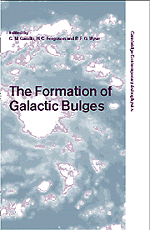Book contents
- Frontmatter
- Contents
- Preface
- Dedication: In Memory of Olin Eggen
- Part 1 Introduction
- Part 2 The Epoch of Bulge Formation
- Origin of Bulges
- Deep sub-mm Surveys: High-z ULIRGs and the Formation of Spheroids
- Ages and Metallicities for Stars in the Galactic Bulge
- Integrated Stellar Populations of Bulges: First Results
- HST-NICMOS Observations of Galactic Bulges: Ages and Dust
- Inside-Out Bulge Formation and the Origin of the Hubble Sequence
- Part 3 The Timescales of Bulge Formation
- Part 4 Physical Processes in Bulge Formation
- Part 5 Bulge Phenomenology
- Part 6 Conference Summary
- Index
Integrated Stellar Populations of Bulges: First Results
from Part 2 - The Epoch of Bulge Formation
Published online by Cambridge University Press: 10 November 2010
- Frontmatter
- Contents
- Preface
- Dedication: In Memory of Olin Eggen
- Part 1 Introduction
- Part 2 The Epoch of Bulge Formation
- Origin of Bulges
- Deep sub-mm Surveys: High-z ULIRGs and the Formation of Spheroids
- Ages and Metallicities for Stars in the Galactic Bulge
- Integrated Stellar Populations of Bulges: First Results
- HST-NICMOS Observations of Galactic Bulges: Ages and Dust
- Inside-Out Bulge Formation and the Origin of the Hubble Sequence
- Part 3 The Timescales of Bulge Formation
- Part 4 Physical Processes in Bulge Formation
- Part 5 Bulge Phenomenology
- Part 6 Conference Summary
- Index
Summary
We present first results from an on-going survey of the stellar populations of the bulges and inner disks of spirals at various points along the Hubble sequence. In particular, we are investigating the hypotheses that bulges of early-type spirals are akin to (and may in fact originally have been) intermediate-luminosity ellipticals while bulges of late-type spirals are formed from dynamical instabilities in their disks. Absorption-line spectroscopy of the central regions of Sa–Sd spirals is combined with stellar population models to determine integrated mean ages and metallicities. These ages and metallicities are used to investigate stellar population differences both between the bulges and inner disks of these spirals and between bulges and ellipticals in an attempt to place observational constraints on the formation mechanisms of spiral bulges.
Introduction
Current thinking considers two major pathways to the formation of spiral bulges. Simplistically, either the bulge formed before the disk (‘bulge-first’, e.g. van den Bosch 1998, and these proceedings), or formed from the disk (‘disk-first’, e.g. Combes & Sanders 1981). Previous studies have shown that bulges of big-bulge spirals (like M31) share at least some stellar population properties with mid-sized elliptical galaxies. They fall along the Dn−σ0 relation (Dressler 1987) and the Fundamental Plane (Bender, Burstein & Faber 1992). Moreover, Jablonka et al. (1996) and Idiart et al. (1996) find that bulges of spirals (as late as Sc) fall along the Mg−σ0 relation defined by early-type galaxies, suggesting that bulges share a mass-metallicity relation with elliptical galaxies.
- Type
- Chapter
- Information
- The Formation of Galactic Bulges , pp. 42 - 45Publisher: Cambridge University PressPrint publication year: 2000
- 3
- Cited by



